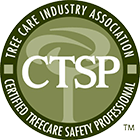TREE PRUNING
Pruning can benefit trees and properties in many ways. Trees that grow too close to structures may need to be pruned back for clearance to prevent damage, mildew, and pests. Trees can also be pruned for aesthetics and to create a vista.
Pruning can be carried out to thin (aka “remove”) dead and weak branches in the tree that could either allow pests to take advantage or create a hazardous situation for the people and property below. Thinning can also provide more light for the tree as well as easy passage for high winds that could otherwise cause branches to break or for the tree to uproot in a storm. Thus thinning reduces falling hazards and makes a stronger structure for the tree.

PRUNING TO STANDARDS
Our team is trained and educated according to ANSI A300 tree pruning standards.
Our arborists know how to properly prune trees to maintain the trees health, and promote the overall goal of pruning. Proper cuts are needed to ensure the healing properties of the tree are allowed to function and allow the tree continue a healthy life. Proper pruning is an art that is a careful balance between the customers’ needs and expectations, and healthy maintenance of the tree.
When we prune, we will not “spike” or “gaff” your trees. Our climbers are skilled in accessing tree canopies with ropes and harnesses which prevent damage to your trees. We can also access your trees with a bucket truck or compact aerial lifts that allow for access in tight spaces.
ANSI A300 TREE CARE STANDARD DEFINITIONS
- Clean: Selective pruning to remove one or more of the following parts: dead, diseased, and/or broken branches. Unless noted otherwise on this proposal, all cleaning will be of branches 1inch diameter or greater throughout the entire crown.
- Crown: The leaves and branches of a tree measured from the lowest branch on the trunk to the top of the tree.
- Leader: A dominant or co-dominant, upright stem.
- Raise: Selective pruning to provide vertical clearance.
- Reduce: Selective pruning to decrease height and/or spread by removing specified branches.
- Restore: Selective pruning to improve the structure, form, and appearance of trees that have been severely headed, vandalized, or damaged.
- Thin: Selective pruning to reduce density of live branches, usually by removing entire branches.
YOUR NEIGHBORS LOVE US!

They did an excellent job removing multiple trees in very tight quarters. Did not damage any other trees of landscaping around them. -Luke Lenzen




